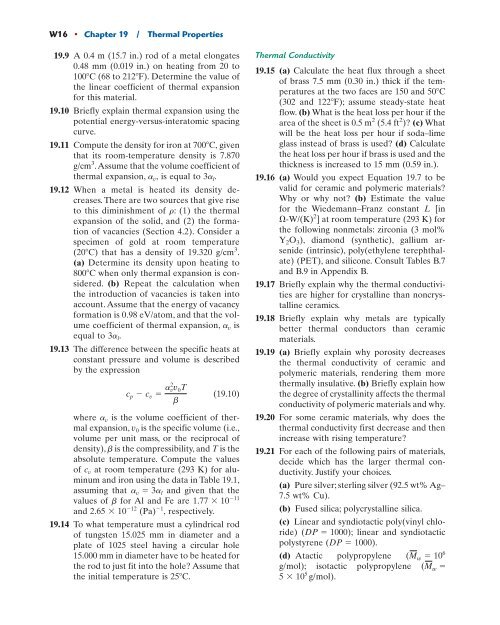Chapter 19 Thermal Properties
Chapter 19 Thermal Properties
Chapter 19 Thermal Properties
- No tags were found...
Create successful ePaper yourself
Turn your PDF publications into a flip-book with our unique Google optimized e-Paper software.
W16 • <strong>Chapter</strong> <strong>19</strong> / <strong>Thermal</strong> <strong>Properties</strong><strong>19</strong>.9 A 0.4 m (15.7 in.) rod of a metal elongates0.48 mm (0.0<strong>19</strong> in.) on heating from 20 to100C (68 to 212F). Determine the value ofthe linear coefficient of thermal expansionfor this material.<strong>19</strong>.10 Briefly explain thermal expansion using thepotential energy-versus-interatomic spacingcurve.<strong>19</strong>.11 Compute the density for iron at 700C, giventhat its room-temperature density is 7.870g/cm 3 .Assume that the volume coefficient ofthermal expansion, a v , is equal to 3a l .<strong>19</strong>.12 When a metal is heated its density decreases.There are two sources that give riseto this diminishment of r: (1) the thermalexpansion of the solid, and (2) the formationof vacancies (Section 4.2). Consider aspecimen of gold at room temperature(20C) that has a density of <strong>19</strong>.320 g/cm 3 .(a) Determine its density upon heating to800C when only thermal expansion is considered.(b) Repeat the calculation whenthe introduction of vacancies is taken intoaccount.Assume that the energy of vacancyformation is 0.98 eV/atom, and that the volumecoefficient of thermal expansion, a v isequal to 3a l .<strong>19</strong>.13 The difference between the specific heats atconstant pressure and volume is describedby the expressiona vc p c v a2 vv 0 Tb(<strong>19</strong>.10)where is the volume coefficient of thermalexpansion, v 0 is the specific volume (i.e.,volume per unit mass, or the reciprocal ofdensity), b is the compressibility, and T is theabsolute temperature. Compute the valuesof c v at room temperature (293 K) for aluminumand iron using the data in Table <strong>19</strong>.1,assuming that a v 3a l and given that thevalues of b for Al and Fe are 1.77 10 11and 2.65 10 12 (Pa) 1 , respectively.<strong>19</strong>.14 To what temperature must a cylindrical rodof tungsten 15.025 mm in diameter and aplate of 1025 steel having a circular hole15.000 mm in diameter have to be heated forthe rod to just fit into the hole? Assume thatthe initial temperature is 25C.<strong>Thermal</strong> Conductivity<strong>19</strong>.15 (a) Calculate the heat flux through a sheetof brass 7.5 mm (0.30 in.) thick if the temperaturesat the two faces are 150 and 50C(302 and 122F); assume steady-state heatflow. (b) What is the heat loss per hour if thearea of the sheet is 0.5 m 2 (5.4 ft 2 )? (c) Whatwill be the heat loss per hour if soda–limeglass instead of brass is used? (d) Calculatethe heat loss per hour if brass is used and thethickness is increased to 15 mm (0.59 in.).<strong>19</strong>.16 (a) Would you expect Equation <strong>19</strong>.7 to bevalid for ceramic and polymeric materials?Why or why not? (b) Estimate the valuefor the Wiedemann–Franz constant L [in-W/(K) 2 ] at room temperature (293 K) forthe following nonmetals: zirconia (3 mol%Y 2 O 3 ), diamond (synthetic), gallium arsenide(intrinsic), poly(ethylene terephthalate)(PET), and silicone. Consult Tables B.7and B.9 in Appendix B.<strong>19</strong>.17 Briefly explain why the thermal conductivitiesare higher for crystalline than noncrystallineceramics.<strong>19</strong>.18 Briefly explain why metals are typicallybetter thermal conductors than ceramicmaterials.<strong>19</strong>.<strong>19</strong> (a) Briefly explain why porosity decreasesthe thermal conductivity of ceramic andpolymeric materials, rendering them morethermally insulative. (b) Briefly explain howthe degree of crystallinity affects the thermalconductivity of polymeric materials and why.<strong>19</strong>.20 For some ceramic materials, why does thethermal conductivity first decrease and thenincrease with rising temperature?<strong>19</strong>.21 For each of the following pairs of materials,decide which has the larger thermal conductivity.Justify your choices.(a) Pure silver; sterling silver (92.5 wt% Ag–7.5 wt% Cu).(b) Fused silica; polycrystalline silica.(c) Linear and syndiotactic poly(vinyl chloride)(DP 1000); linear and syndiotacticpolystyrene (DP 1000) .(d) Atactic polypropylene (M w 10 6g/mol); isotactic polypropylene (M w 5 10 5 g/mol).












![Data Structures and Algorithms in Java[1].pdf - Fulvio Frisone](https://img.yumpu.com/30982515/1/190x245/data-structures-and-algorithms-in-java1pdf-fulvio-frisone.jpg?quality=85)
![(Microsoft PowerPoint - Topic 4.ppt [Mode de compatibilit\351])](https://img.yumpu.com/30966934/1/190x245/microsoft-powerpoint-topic-4ppt-mode-de-compatibilit351.jpg?quality=85)

